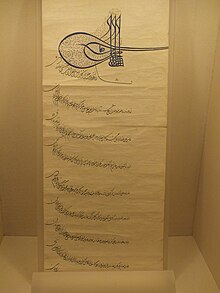Mülk

Mülk was a form of land holding in the Ottoman Empire.[1][2]
Characteristics of mülk[edit]
Mülk was similar to freehold land; owners could buy, sell, and mortgage freely. It was exempt from some kinds of land taxes.[3] Mülk was about more than just the land; it might also include the right to annual malikane payments from tenants and farmers.[4]
Context[edit]
In much of the near east, mülk can be contrasted against miri, which was effectively state-controlled land (perhaps a former mülk forfeited to the state when the owner had no heir to pass it on to).[5]
In some ways, mülk was similar to waqf property.
See also[edit]
References[edit]
- ^ Forni. "Land tenure policies in the Near East". FAO. Retrieved 28 October 2012.
- ^ Türkische Wirtschafts- und Sozialgeschichte (1071-1920). p. 125. ISBN 9783447036832.
- ^ "Mulk". Retrieved 28 October 2012.
- ^ İslamoğlu-İnan (1994). State and Peasant in the Ottoman Empire: Agrarian Power Relations and Regional Economic Development in Ottoman Anatolia During the Sixteenth Century. p. 135. ISBN 9789004100282.
- ^ "Ottoman Land Registration Law as a Contributing Factor in the Israeli-Arab Conflict". Archived from the original on 16 September 2008. Retrieved 28 October 2012.
